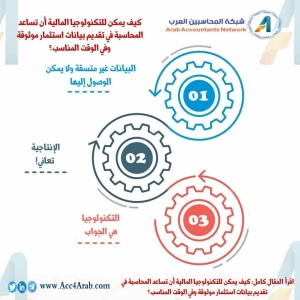عرض العناصر حسب علامة : تكنولوجيا
الثلاثاء, 24 مايو 2022 07:23
إنفوجرافيك.. كيف يمكن للتكنولوجيا المالية أن تساعد المحاسبة في تقديم بيانات استثمار موثوقة وفي الوقت المناسب؟
نشر في
إنفوجرافيك
موسومة تحت
الأحد, 17 يناير 2021 13:40
توقعات الرؤساء الماليين في السوق المتوسطة لعام 2021
يتوقع غالبية الرؤساء الماليين في السوق المتوسطة حدوث انتعاش اقتصادي وزيادة الإيرادات لشركاتهم في عام 2021
معلومات إضافية
-
المحتوى بالإنجليزية
Midmarket CFOs expect revenue growth in 2021
By Michael Cohn
A majority of middle-market CFOs are predicting an economic recovery and revenue increases for their companies in 2021, according to a new survey by BDO USA.
The 2021 BDO Middle Market CFO Outlook Survey, found that 60 percent of the 600 CFOs polled at midsized companies anticipate economic recovery, while 56 percent expect revenue increases, in 2021. In addition, 62 percent of the survey respondents anticipate their company will be thriving a year from now.
Nearly three-fourths of the middle-market CFOs said their companies received government assistance as a result of the crisis. Cost cutting and reorganization for resilience are the top priorities for many CFOs.
The pandemic made an impact on nearly every company, and 39 percent of the CFOs polled indicate that the pandemic accelerated digital transformation at their companies, while 38 percent said it opened new expansion opportunities for products or services and 31 percent for new geographies.
“Unprecedented was the buzzword in 2020 for good reason,” said BDO USA CEO Wayne Berson in a statement. “Many middle-market companies persevered through levels of transformation and disruption in one year akin to what some companies experience in a full lifecycle. But rather than hunker down and endure, middle market leaders endeavor to move forward to refresh strategy and enhance agility. While we’re not out of the woods, the middle market is poised to pivot to new levels of potential.”
Deal flow was unsteady last year as CFOs assessed and reassessed the possible outcomes of the pandemic’s impact on their business. However, CFOs appear to be more optimistic this year, with 29 percent planning to seek private equity investment, 24 percent want a merger or acquisition and 20 percent hope to pursue an IPO.
While returning to the office or floor is critical for many CFOs, 43 percent of the respondents said they would increase or establish permanent remote work options. Office space is likely to be downsized, with 28 percent of the CFOs polled planning to eliminate or consolidate their current real estate footprint. CFOs also intend to build a more flexible workforce through automation (38 percent) and outsourcing (32 percent).
The main threats cited by the CFOs include a prolonged economic downturn, competitive pressure, supply chain disruption and falling behind on technology or innovation.
Coming out of an election year, tax challenges are also going to be important, with understanding total tax liability (19 percent) and navigating shifting trade and tariff policies (17 percent) among the top challenges cited by the CFOs. Managing disclosures and risk factors is also a top financial reporting challenge as the CFOs try to assess how to communicate impact of COVID-19 on matters that may be material to stakeholders.
نشر في
موضوعات متنوعة
موسومة تحت
الأربعاء, 21 سبتمبر 2022 11:45
اختيار رئيس جمعية كاليفورنيا للمحاسبين القانونيين كرئيس تنفيذي جديد لمعهد المدققين الداخليين
سيخلف الرئيس والمدير التنفيذي لجمعية كاليفورنيا للمحاسبين القانونيين أنتوني بوجليس القائد القديم لمعهد المدققين الداخليين، ريتشارد تشامبرز
معلومات إضافية
-
المحتوى بالإنجليزية
CalCPA chief picked as new IIA CEO
By Michael Cohn
California Society of CPAs president and CEO Anthony Pugliese will be succeeding the longtime leader of the Institute of Internal Auditors, Richard Chambers, as the IIA’s new president and CEO at the end of March.
The IIA announced Tuesday that Pugliese will be taking the reins of the Lake Mary, Florida-based organization when Chambers steps down March 31. Chambers announced his retirement last year after leading the IIA for 12 years, and the institute engaged executive search firm Korn Ferry to find a replacement (see story). They identified Pugliese as a strong candidate to succeed Chambers.
Apart from his experience leading CalCPA -- the largest state CPA society, with 45,000 members -- Pugliese was also a longtime official at the American Institute of CPAs and later the Association of International Certified Professional Accountants. From 1997 through 2018, he held important leadership positions at the AICPA, including chief operating officer; executive vice president of membership, technology and learning; senior vice president; and vice president of business reporting and member innovation. Among other things he oversaw the AICPA’s $50 million relocation from New York to North Carolina.
Pugliese initially plans to meet with other officials and members at the IIA to hear about their concerns as he works closely with Chambers during the transition period. He sees opportunities ahead for the organization, even as it adjusts to new ways of working during the COVID-19 pandemic.
“We’ve seen a deepening of the role for internal audit,” Pugliese told Accounting Today. “It’s understanding the trajectory of internal audit and continuing a broadening role across the profession. There’s just so much going on. We’re looking at a whole range of new risks and opportunities for the profession right now. Our primary goals are growth and to make sure we’re doing the advocacy that’s necessary for the changing times.”
Institute of Internal Auditors incoming president and CEO Anthony PugliesePhoto by Richard Morgenstein
He is seeing more advanced technology being used by auditors and wants to encourage early involvement of students in the profession. “We have a digital transformation that we’re working on not just at IIA, but also the transformation that has to occur across the profession,” said Pugliese. “By that I mean blockchain, AI, modernization of systems, etc., and making sure we've got our eyes set on the next generation of internal auditors, beginning in high school and early college years.”
As CEO of the IIA, Pugliese will manage the nearly 80-year-old organization, which boasts more than 200,000 members, 156 chapters and 112 affiliates in nearly 200 countries and territories. He plans to focus on improving membership services, creating new approaches to learning and competency development programs, completing the IIA’s multimillion-dollar digital transformation initiative, and enhancing the value of internal audit, especially when it comes to addressing organizational risks and opportunities.
“We are thrilled to welcome Anthony to the IIA,” said IIA global chair Jenitha John in a statement Tuesday. “He is an articulate, well-informed, passionate and results-driven leader with a consistent track record of great successes that inspire and benefit not only his organizations but, importantly, the members they serve. His strategic direction, coupled with his insight of internal audit’s evolution and the instrumental role technology holds for its future, will help the IIA grow and build value for our members and customers around the world.”
Pugliese has been frequently recognized as one of the Most Influential People in the profession by Accounting Today. He holds the AICPA's Chartered Global Management Accountant and Certified Information Technology Professional credentials, and is licensed as a CPA in California, Georgia and North Carolina.
Priorities for the future
He has worked on encouraging more diversity, equity and inclusiveness in the profession at both the AICPA and CalCPA. At CalCPA, he has also been working on a project with the Institute of Management Accountants on a study of diversity and inclusion in the profession. He and IMA president and CEO Jeff Thomson plan to discuss the topic during an online event on Thursday.
“All facets of the profession today are facing this problem,” said Pugliese. “The problem maybe has gotten better as far as underrepresented populations moving into the profession. But what we're seeing now is those that do are leaving at a disproportionate rate, so that would lead us to believe the problem is still in existence. The goal of the research with the IMA is to really get down to not just strategies on how to improve diversity within the profession, but really what's causing the problem to begin with. A lot of people have different ideas and a lot of companies with the best intentions tend to approach the problem by making sure they hire enough people that have backgrounds in underrepresented populations. But that really doesn't get to the root of the problem, which is feelings of inclusiveness and so forth. We’re looking at that now, and I'm really excited to look at it within the internal audit profession soon after I get started.”
Another priority for Pugliese will be educating members about the latest audit technology. “A lot of the time internal audit is acting as a complement to external audit,” he said. “They're going to be using a lot of the tools that external audit uses. That’s one angle where we need to have education across the profession so our members understand what’s being done on the external audit. For the most part they do, but technology continues to change.”
The Institute of Internal Auditors partners with other organizations besides the IMA. It’s part of an initiative called the Anti-Fraud Collaboration with the Center for Audit Quality, Financial Executives International and the National Association of Corporate Directors. Together, they released a report Tuesday analyzing fraud trends in recent years based on enforcement actions by the Securities and Exchange Commission (see story).
“Internal audit is always focused, at least in my experience, on fraud and fraud prevention, making sure to be alerted to the risks that are present there,” said Pugliese. “I oversaw the internal audit function for 15 years at AICPA. When I left, it had actually evolved into a pretty large team and that was one of their primary goals. I think where internal audit became even more valuable in that experience for me was when AICPA went global in 2016. Companies that are global have such a range of controls and regulation concerns that they have to deal with. As we become more and more global as a community across the planet, I think there is a much wider role for internal audit, and they’ve probably been operating in that for a long time.”
Pugliese has already begun working with Chambers during the transition. “We intentionally have about a month of overlap,” he said. “But Richard and I have already started our calls on a regular basis, so I think it’s a bit more like three months of us being able to work together and gain from his vast knowledge.”
He has been reading Chambers’ books, such as “Lessons Learned on the Audit Trail.”
“I'm beginning to get more and more entrenched into what he’s learned and his perspectives,” said Pugliese. “That’s been very helpful. Richard and I are going to be working closely. I'm sure he'll be OK if I call him after his last days. He’s been a fixture in the profession for over 12 years, and before that. He's been a great mentor.”
نشر في
موضوعات متنوعة
الأربعاء, 13 يناير 2021 12:23
اثبت حياتك المهنية في المستقبل بمهارات تحليل البيانات
ليس من الغريب أن تكون التكنولوجيا والبيانات الضخمة منتشرة في كل مكان في العمليات اليومية لمعظم الأنشطة التجارية
معلومات إضافية
-
المحتوى بالإنجليزية
Future-proof your career with data analytics skills
By Jack Castonguay
It’s no surprise that technology and big data have become ubiquitous in the day-to-day operations of most businesses, regardless of size or industry. Data scientists, data analysts, and non-IT professionals with data analytics knowledge have become critical in their organizations’ quest to transform raw data into workable and actionable formats that can be used to identify trends, draw meaningful conclusions, and model future outcomes.
As the proliferation of data analytics has expanded, public accountants have found themselves in front of a unique opportunity that allows them to set themselves apart from their colleagues and future-proof their careers by developing their expertise in data analytics — an expertise that will ultimately save their clients time and money.
What is data analytics?
Simply put, data analytics is the process of collecting, inspecting, organizing, and transforming data to identify useful information that informs decision-making. It’s more than a tool or input — it’s a process that, when utilized correctly, provides a 360-degree view of the problem being solved, allowing decision-makers to make the best decision with the best information available.
Specifically, accountants use data analytics to help businesses uncover valuable insights within their financial statements, reduce costs, identify process improvements that increase their efficiency, and better manage risks.
Prior to the growth in data analytics, enabling a business or clients to reach their goals has been a manual and time-consuming process based predominantly on institutional knowledge and relationships. By understanding and mastering data analytics, accountants can future-proofing their career, expediting the learning curve, regardless of the career path they choose.
Professionals in public accounting can use these analytical skills to make sense of the massive quantities of financial information available to evaluate business performance, identify and manage risk, and analyze customer behavior to anticipate market trends more efficiently and accurately than ever before.
These skills are not going away anytime soon - and ultimately, the most efficient firm or advisor will win the business. Enhancing their skills in data analytics will only increase an accountant’s chance of success, and ensure their career thrives into the future.
As this knowledge and awareness of its benefits proliferate, firms and companies will look to hire those with this in-demand skill set — complementing and enhancing the traditional accounting education and experience. Public accountants can move to the top of the resume stack with this skill set, while genuinely putting themselves in a position to better serve their clients and complete their job.
Without this knowledge, professionals will quickly see their business and promotional path suffering — as clients seek the most efficient route and opt for their competitors who are able to streamline manual tasks and identify new relations, all while saving them money.
A PwC report, “Data Driven: What Students Need to Succeed in a Rapidly Changing Business World,” helps to encapsulate the important data analytics-related skills that accounting professionals, such as public accountants, should have. They include:
The ability to consider new sources of data and research and identify anomalies and risk factors in the data.
The ability to use exploratory multivariate statistics, inferential statistics, visualization tools, optimization methods, machine learning, and predictive analysis tools.
The ability to understand relational and nonrelational databases and combine multiple datasets from each.
The ability to use simple vendor risk dashboards and filters to minimize inefficiencies and human error.
The ability to perform data and process mapping from a regulatory and risk-assurance view.
The ability to identify and frame key management decisions and their related metrics to make business solutions more effective and efficient.
Building a skillset
While the reason accountants need skills in data analytics might be clear by now, the how likely isn’t. Juggling important professional development while working can be tough — but it’s absolutely possible and essential to continue advancing in your career.
For me, gaining these skills, I practiced the following:
Take breaks and inform your friends and family. When students study for the CPA Exam, I always encourage them to tell their loved ones what they’re doing, because juggling studying with a job and other day-to-day responsibilities can be exhausting, and having support is hugely important. This tip is just as relevant when upskilling. Remembering to take breaks is necessary - data analytics skills are a fantastic asset, but only if you’re not too burned out to use them.
Use a data analytics course. Much like any other skill or subject, if you study piecemeal or without structure, it will be difficult to retain and organize the information. Using a course, ideally one for accounting professionals, is crucial to ensuring that the knowledge you gain is relevant and that you understand and can apply it correctly.
Know how to showcase these skills after achieving them. While obtaining these skills can be fairly simple when using one of the many online resources available, it’s important that you know how to showcase them and promote yourself once you have upskilled. Finding a data analytics course that offers a certificate upon completion and LinkedIn badges can be a great way to highlight your accomplishments and increase your chance of promotion or transitioning to your next role.
As data analytics and its importance to entities of all sizes continue to grow, it becomes a higher priority for hiring managers and company owners when looking to hire or promote. As the accounting profession continues to evolve to include workers with atypical backgrounds, it is clear that those professionals who are dedicated to upskilling and fine-tuning their professional skill set will succeed in the long-term.
نشر في
موضوعات متنوعة
الأربعاء, 21 سبتمبر 2022 11:40
كيفية جمع المستندات من العملاء أثناء العمل عن بُعد؟
مع عمل الكثير منا من المنزل بسبب فيروس كورونا ، فإن الطريقة التي نعمل بها مع العملاء بأكبر قدر ممكن من الكفاءة أصبحت أكثر أهمية من أي وقت مضى
معلومات إضافية
-
المحتوى بالإنجليزية
How to collect documents from clients while working remotely
PRACTICE MANAGEMENT, WORKFLOW TOOLS
April 23, 2020 / Mariette Martinez, EA
With the tax deadline postponed and many of us working from home due to the coronavirus, being as efficient as possible with the way we work with clients is more important than ever. To be successful, we need to move more clients online. This starts with operating a 100 percent cloud-based practice and implementing an effective process for document collection.
Since my clients’ technical skills varied from highly tech savvy to new online app users, it was essential that the technology and client implementation would be seamless and user friendly for my multiple client types. I also wanted to keep our workflow as simple as possible, so using the fewest number of applications would create the best-case scenario. I wanted to synchronize what I had already implemented in my current operational workflow, while partnering that with serving my clients’ needs to stay connected. Ultimately, these processes provide me the necessary documents to keep our work flowing seamlessly.
I know that making these kinds of changes in your practice isn’t easy – and it takes time, especially now that we’re sheltering in place. According to an Intuit® Accountant Panel survey in March 2020 that asked about the most pressing issues due to the coronavirus, 42 percent of the 247 respondents said that getting documents from their clients was by far their biggest struggle when working virtually.
Whether you’re very experienced in collecting documents from your clients without seeing them in person – or if this is new for you because of the coronavirus, here are several best practices I can share to make the process easier.
The essence of a strong document collection platform, also referred to as a document portal, is a centralized, secure location to share documents and collaborate with clients and staff.
We chose Citrix ShareFile for our preferred solution, but several other options include Box, Dropbox, Google Drive, SmartVault and Intuit Link.
Several platforms allow firms to personalize the document portal experience with their firm branding to provide a more trusted and professional client experience. These document platforms also commonly enable:
Collaborating on documents and editing in real time.
Encrypted client requests with notifications and reminders.
Encrypted email for those times when email is the best way.
Sending and receiving of large files.
Most importantly, the document collection solution you choose should include a high level of encryption for your files, large space storage capabilities that can scale with your firm, and online and desktop automated syncing of all stored files. You definitely don’t want to encourage clients to send you their documents over email. The bottom line is that you and your clients should be able to securely share, collect, and collaborate on documents no matter where you are.
In addition, several platforms integrate with other helpful tools. One of my favorite integrations is Slack with Google Drive. What are some of your favorite integrations? Leave a comment below to share your recommendations.
One other concern: What do you do if your clients don’t want to send you their documents through the cloud? These “shoebox” clients may not be tech savvy and prefer physically dropping off their information to you, but if you’re working remotely and cannot see them in person, what do you do? You don’t want to lose a long-term client, so here are several recommendations:
Sit down with them over a phone conversation, or if they can figure it out, a web call, to explain how your portal works. Walk them slowly through the process and perhaps have them practice or test uploading something to you.
Record a quick video that also explains the process and send this to your clients who may need help using the platform. You can also include a link to the video in your email signature. Here’s an example of this type of video.
If a client absolutely insists on dropping off or mailing their documents, the best advice I can give is to go with the flow, and ensure your clients have a secure, private place to leave their documents with you outside your place of work to avoid contact during drop off. Most likely, this will be a very small slice of your client base.
When you find and implement the winning platform, you not only stay safe during this time of social distancing, but you will save time on document collection in your practice and witness the magic of productive collaboration. Good luck!
نشر في
موضوعات متنوعة
الإثنين, 11 يناير 2021 13:36
كيف يمكن للتكنولوجيا المالية أن تساعد المحاسبة في تقديم بيانات استثمار موثوقة وفي الوقت المناسب؟
معلومات إضافية
-
المحتوى بالإنجليزية
How fintech can help accounting deliver timely, trustworthy investment data
By Ted Meissner
Opportunities don’t stick around long, especially in the fast-moving financial world. When you’re managing a large, diverse portfolio, you need to respond quickly when opportunities arise, and you need up-to-the-minute data to act with any confidence. But accounting and investment pros can’t audit sources and verify data quickly enough to ensure the information is both updated and accurate. Without insight into the source and age of data and fresh analytics, they’re operating at a huge disadvantage.
There are several reasons why reliable data is so hard to come by. The need to reconcile information from multiple sources is a big part of the problem. Data is often siloed throughout the organization, and input from numerous departments is anything but consistent. When managers must sort through stale data, updates, revisions and inconsistencies, it’s difficult to trust the information. They’re not alone in their frustration. The concern extends up to the C suite, where the chief financial and operations officers (CFOs and COOs) and chief information officer (CIO) are looking for solid data to support sound decisions and satisfy investment committees.
Fortunately, fintech can help address this problem. State-of-the-art accounting solutions provide full transparency on the quality of the data, revisions, corrections and approvals. That results in trustworthy data — the foundation for smart, fast, strategic decisions.
Data is inconsistent and inaccessible
With a manual process, it’s difficult to ensure data consistency and availability. Multi-asset data comes from a number of sources, including fund managers and accountants, sometimes including outside contractors. Often, they use different formats and timetables, which can make it hard to collate data. Handling data collection manually is a slow, tedious process full of duplication and prone to human error. Once the information has been gathered, someone has to take the time to reconcile the results into something that makes sense.
That’s easier said than done. When staff members handling different functions import and rekey details into a variety of applications, data can be stuck in those apps and siloed in those departments. Many individuals and departments maintain separate spreadsheets for their own purposes and don’t share all the information across the organization.
Given these obstacles, it’s easy to understand why it’s hard to get accurate data that is up to date, consistent across the organization and ultimately reliable.
Productivity suffers
It’s not unusual for accountants to handle all non-investment functions in an investment firm, including tax and compliance functions as well as accounting. In addition, they’re often assigned responsibility for performance reporting and contribution/attribution analysis. That’s all well within their capability, but it’s hard to accomplish using substandard tools such as spreadsheets.
The situation gets even more complicated when the work isn’t handled in-house but outsourced to outside accounting firms. When debits and credits are booked externally, there can be a lack of detailed audit trails for internal accountants to follow. Additional problems can arise when third parties don’t know what form the data should take. Companies are unhappy when data isn’t ready when needed or is difficult to reconcile.
Shadow systems add to the complexity. These workarounds often require companies to redo the work they’re paying an outside vendor to deliver. That extra step may provide more confidence in data, but it’s expensive and inefficient, and it can wind up creating yet another data silo.
Faced with these realities, accountants can feel they’re unable to provide their best work despite their best efforts. Spending hours on routine tasks such as rekeying data into diverse systems rather than doing productive value-added work is a waste of their time and talent, leading to job frustration.
Technology is the answer
Automation can resolve many of these problems. Fintech software providers offer next-generation solutions that ingest data, record it once and distribute it to the appropriate systems for portfolio accounting, performance reports and analyses, and private investment tracking. Indexing provides both an audit trail and insight into data quality, and algorithms can be used to analyze key indicators and assign data a confidence rating.
The investment industry now has the tools to solve the longstanding problems it has had with data. By harnessing technology, firms can enjoy more control and enhanced efficiency and have more confidence in the integrity of their data. In the end, this will give them more time to manage portfolios and deliver even more valuable service to their clients.
نشر في
موضوعات متنوعة
الأربعاء, 21 سبتمبر 2022 11:36
قائمة مهامك لنجاح شركتك في 2021
نجتهد كل عام في إنشاء عشرات من المهام المختلفة والمتميزة لوضعها في جدول التقويم الخاص بك على أمل تحفيزك لجعلك مميزاً في مجالك عن غيرك
معلومات إضافية
-
المحتوى بالإنجليزية
Your 2021 to-do list
By Daniel Hood
Whatever plans you had for 2020 were likely disrupted by the events of the year, so it seems presumptuous to try to set anything in stone for 2021. We’re not going to let that stop us, though, and so, as we do each year, we’re using this space to offer you 12 tasks you can put on your to-do list right now.
January
online-zoom-meeting.jpg
Ģirts Raģelis/Girts - stock.adobe.com
With so many staff working from home, it’s hard for them to just walk down the hall to ask a question. Instead, offer them “virtual office hours” — set up an open Zoom call or Google Meet for an hour or two each week where you’ll be ready to talk to any employee who calls in.
February
Lease contract, close-up
andia-faith/andiafaith - stock.adobe.com
Hopefully, we’ll all be talking about resuming regular work regimes, so this would be a good time to survey your staff about when, whether and how they want to return to the office — if they want to return to the office at all. You also might want to dig out your lease and see if you have any options for reducing the amount of space you use
March
Tax extension form
Picasa
Pick a date, and tell any clients who don’t have their tax docs in by that date that they’re going on extension. Then stick to it.
April
p198t4eqkm4031vfi13bq164hhfc6.jpgAfter each tax return you complete, take a brisk five- or 10-minute walk.
May
p1b6951ta71s2i1rao1m8e1ojh12dog.jpg
yurolaitsalbert - Fotolia
Start making sure everyone has a chance to be heard in meetings, either by calling out interruptions (which are rude, anyway) or by instituting a turn-based system where you deliberately give everyone a chance to weigh in on the topic — or both. The loudest person isn’t always right.
June
Summer reading 2019
Dudarev Mikhail/Dudarev Mikhail - stock.adobe.com
Pick a business-related article, video, podcast episode or book that caught your interest, and share it with staff. Then meet up virtually (break into smaller groups, if necessary) to discuss it and how it applies to your firm. Repeat on a monthly basis. Accept suggestions from staff.
July
ft-disposal.jpg
Africa Studio - Fotolia
Pick a single process at your firm — whether internal or client-facing — and ruthlessly drive out any paper-based steps. Repeat.
August
bitcoin-three.jpg
prima91 - Fotolia
Investigate accepting new types of payments — everything from credit cards to ACH payments, PayPal, Venmo and cryptocurrencies — and adopt whichever will work for your clients.
September
p18qaui29kes61nbmjj71ic51jvj7.jpg
creative soul - Fotolia
Experts had been predicting a worldwide pandemic like the coronavirus for 30 years. Research some other challenges that experts say are likely in the future, and figure out how they’ll impact your firm — or your clients. (Climate change is certainly a good choice here, but bonus points for going beyond that.)
October
Technology gap
Sergio Donà/itestro - stock.adobe.com
Conduct a technology inventory. Does everyone on staff have all the screens, scanners, tablets, etc., that they need? Is all their software appropriately licensed, and all their security software up to date? Alternatively, check the service-level agreements on one of your cloud-based apps. Are they living up to the terms?
November
New York City map with pushpin
Robert Byron/Rob Byron - Fotolia
Check your client list to see what percentage of them are within 25 miles of you. Then go through your service offerings to determine how many actually require you to be able to meet face to face with the client. Draw your own conclusions.
December
p18rfc8oi6s7djdg32ku481ush6.jpgWe’ve suggested this before, but as the years get harder, it’s only getting more important: Close your office between Christmas and New Year’s.
https://www.accountingtoday.com/list/your-2021-to-do-list?utm_campaign=accountingtoday-tw&utm_content=socialflow&utm_medium=social&utm_source=twitter
نشر في
موضوعات متنوعة
موسومة تحت
الأحد, 03 يناير 2021 13:38
خمسة أشياء يجب التفكير فيها في عام 2021
معلومات إضافية
-
المحتوى بالإنجليزية
5 things to think about in 2021
By Susan S. Coffey
December 31, 2020, 9:25 a.m. EST
This year showed us that disruption could happen at any time, but as a forward-thinking and innovative profession, it also showed us that we were prepared to handle it. While it’s true that 2020 disrupted how accountants worked, it didn’t change the importance of what we do — in fact, it showed us that we are more valuable than ever to our clients and employers because of our agility, adaptability and ability to problem-solve during times of extreme challenge.
We can be almost certain that the next few years will continue to bring the unexpected. We’ll need to keep a sharp eye out for emerging trends and changes impacting the business environment, and therefore our profession, and evolve to continue meeting the demands of a constantly changing, disruptive world.
Here are some of the things I’m thinking about as we go into 2021 that I think are poised to elicit change in our profession and how you can act to make the most of them.
1. Technology is impacting what we do at an exponential rate, and we need to embrace it. 2020 showed us that one event could accelerate what we thought would take years to change. While the pandemic upended our lives, it also fast-tracked our adoption of technologies like cloud-based solutions and digital communications tools, and hastened our need to address technology-related challenges like cybersecurity. The most prepared practitioners had already leveraged advanced technologies. Those who hadn’t quickly realized the value and pivoted.
Now is the time to reflect on the ways your firm has used technology this year and strategize how you can adopt emerging technological solutions for your firm’s management and client services.
2. Trust in the disclosure of nonfinancial information is increasingly important. The pandemic increased attention on how businesses interact with the world around them. A focus on a diverse and inclusive workforce — and the impact of natural disasters— are resulting in more and more companies thinking about the ways social and environmental issues affect how they operate and communicate the value of their businesses. This shift in business reporting provides opportunities for us to help our clients and employers make sense of how their business practices impact people, communities and the planet.
I’ve been an advocate of environmental, social, and governance reporting and related assurance for many years through the Association of International Certified Professional Accountants’ sustainability and integrated reporting initiatives, and I’m excited to see business and regulatory communities evolve around these topics. I believe there is a huge role for the profession in facilitating meaningful reporting and providing much-needed trust that builds stronger businesses. Accountants are uniquely qualified to measure, report and provide assurance on consistent, comparable and meaningful sustainability-related information. Here are some resources and learning to help you take advantage of this opportunity.
3. Committing to lifelong learning is mandatory. According to the newly released World Economic Forum Future of Jobs report, in-demand skills will change considerably over the next five years. Surveyed employers said the top skills needed by 2025 include critical thinking and analysis, problem-solving, active learning, resilience, stress tolerance and flexibility.
Clients, businesses and organizations will continue to need new and different things from us, and we must commit to constant reinvention. This requires new skills. I include myself in this category and have been advancing my own technological and people skills. I encourage others in the profession to do the same, and a good place to start is the Go beyond+ disruption podcast.
4. Successful firms and businesses are putting diversity and inclusion at the forefront.Companies that are more diverse and inclusive are more attractive to job seekers. They also have better outputs and productivity. However, that doesn’t mean every company is making diversity, equity and inclusion a priority. According to one Accenture report from earlier this year, only 34 percent of leaders identified diversity efforts as a priority at their organization.
Our profession is embracing the diversity of those we serve, but to maximize the benefit, we must create opportunity in leadership positions within our organizations so those we recruit can see themselves thriving and advancing. We support professionals and firms with resources and training to help with your diversity, equity and inclusion efforts.
5. Young people will want to join our profession because of the value we create and the good we do.For many young people, the pandemic has intensified a desire to do good in the world via meaningful employment. They had already considered themselves purpose-driven but are now even more motivated to make a positive impact on the world around them.
Accounting is already an attractive career choice, and as we evolve and add additional services to our client service portfolios, it will become ever more attractive. We're demonstrating our profession is purpose-driven, serves the public good and drives sustainable business. Accountants’ role in the pandemic — particularly supporting small businesses’ access to the Paycheck Protection Program — reinforces our role as a purpose-led profession. The work we are doing around ESG reporting and assurance is similarly appealing. And the association is recognizing the profession’s purpose through our efforts to evolve the CPA. Through education and the CPA Examination, we are positioning the profession to continue protecting the public interest and driving resiliency in business.
I encourage you to reach out to young professionals and students in your area and talk to them about the ways our profession engages in these issues and how they can contribute through a career in accounting.
Get ready for more
In this year of tremendous disruption, it feels like the future has arrived faster than we anticipated.
It’s likely 2021 will also be a disruptive and transformative year, but it’s in times like these that we can truly find the extraordinary. By embracing disruption and leaning into a new, digital, dynamic era, we can reimagine our roles and set the pace of change for the profession, businesses, economies — and ourselves.
نشر في
موضوعات متنوعة
موسومة تحت
الأربعاء, 30 ديسمبر 2020 18:26
خمسة تنبؤات تقنية لعام 2021
ليس هناك شك في أن عام 2020 كان عامًا مضطربًا، وأعتقد أننا جميعًا شعرنا أننا في بحار عاصفة لبعض الوقت
معلومات إضافية
-
المحتوى بالإنجليزية
5 enterprise technology predictions for 2021
By Stephen Boals
December 28, 2020 12:06 PM
There is no doubt that 2020 was a turbulent year, and I think we all felt we were out to stormy seas for a bit. But winter has arrived and, with it, another cold breath of uncertainty. Where do we go from here when examining our strategic imperatives? Do we have a crystal ball to predict what will happen in the coming year? Well, I whipped out my crystal ball (actually, I had really long conversations with industry experts, customers and partners, and scrutinized a lot of research) to make some predictions for 2021.
Coronavirus remote work telecommuting
Claire Tu, an employee at Reprise Digital, works from her home in Shanghai during the coronavirus outbreak.Qilai Shen/Bloomberg
Remote work until fall
Optimistic people believe we will be back and lounging in the corporate offices by spring. If you are in sync with Bill Gates, we are just over halfway through the pandemic. I think we are somewhere in between, with most agreeing on a fall timeline for returning to the office. But will we really ever get “back” to the office? 2021 will be the year of the hybrid work mode, with over half of our workforce on a permanent WFH plan.
Hackers will target remote workers
Long gone are the days of the corporate firewall, accompanied by all assets locked down virtually behind this protective measure. I cannot imagine dealing with hundreds or thousands of remote access employees, giving them office-like access to private company resources and ensuring the security for those assets. Outside of the corporate domain, end-user home networks and computer assets are now vulnerable to hackers as a path to the center of the corporate domain — at higher levels than ever before. I compare the vulnerability of COVID-19 and the ICU bed count: IT can handle remote access at lower rates but now that everyone is working remotely, this surge of activity can overwhelm both small and large organizations looking to protect their realm.
Cloud revenue will skyrocket
You can no longer kick the can down the road. The cloud is here and the migration of resources is inevitable. We are seeing cloud interest from verticals that never before would have considered it an option. Financial services, healthcare and other industries are realizing they have to be prepared for unplanned and uncertain events. Holding out in their on-premise bastions is hampering their agility and flexibility. I was on a panel last week about the rise of the cloud and leveraging multiple cloud providers. One of the participants likened the cloud to the invention of electricity and the pervasive electrical grid. If you are one of the holdouts using candles and all the competition has electrical lights, machinery and heat, you will lose.
On-premise ERP will die
ERP systems have always been an on-premise ball-and-chain for the enterprise, preventing movement to the cloud. It’s disorganized and a tangled web of customizations, satellite apps, reports and sunk costs were the bane of the accounting world, as well as a blockade on the high road to “cloudness.” I have seen a noticeable shift in the desire to recreate the ERP app web through SaaS offerings and a strategy of public and private cloud offerings. The rise of integration platforms (iPaaS) has also made data transport and migration a seamless, affordable exercise. In the past, this was either not possible or prohibitively expensive.
Businesses will reinvent themselves — again
The only certainty is uncertainty as we breach the wall to exit 2020 and arrive in the new year. Flexible and agile digital organizations will be able to weather challenges and storms that the upcoming year will bring. Businesses that can reorganize and reinvent will be the winners.
How will your organization fare in 2021?
https://www.accountingtoday.com/list/5-enterprise-technology-predictions-for-2021
نشر في
تكنولوجيا المعلومات
موسومة تحت
الثلاثاء, 29 ديسمبر 2020 10:11
رئيس ضرائب كي بي ام جي يخطط للعام المضطرب المقبل
يتوقع نائب رئيس الضرائب في KPMG، جريج إنجل، عامًا آخر من التغييرات المضطربة في الوظيفة الضريبية للشركة
نشر في
موضوعات متنوعة
موسومة تحت










